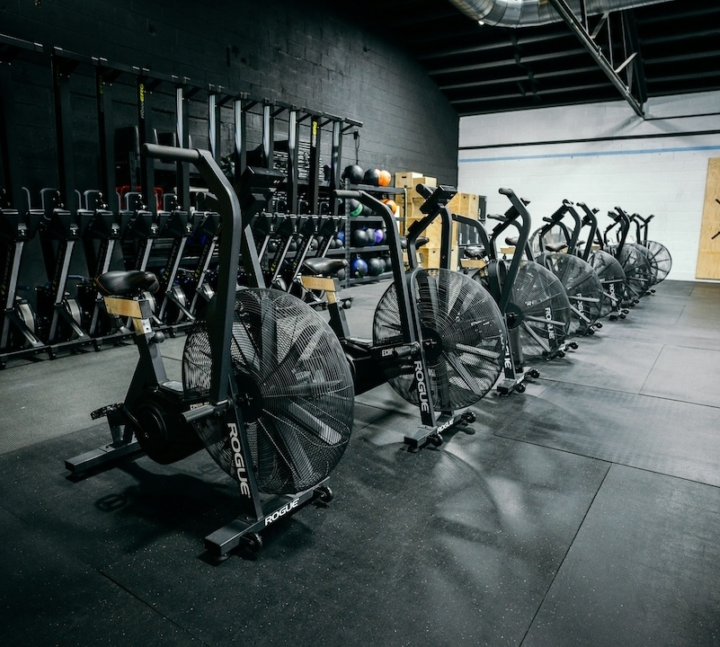Exercise
Power Sled Push
How to Perform - Power Sled Push
- Select a sled with appropriate weight, position it on a flat, even surface, and grip the handles at chest height with your arms extended.
- Adopt a staggered stance with one foot in front of the other, keeping your feet hip-width apart and your weight primarily on the balls of your feet.
- Lean forward at approximately a 45-degree angle, maintaining a neutral spine with your core engaged and shoulders directly over your hands.
- Inhale deeply, brace your core, and drive through the balls of your feet while extending your legs powerfully to initiate movement.
- Push the sled forward by driving one leg after the other in a marching or running motion, maintaining the forward lean throughout the movement.
- Keep your arms straight and locked, using them as rigid connectors rather than pushing with your upper body, while breathing rhythmically.
- Maintain a low hip position and avoid standing upright during the push, focusing on leg drive and core stability throughout the movement.
- Continue pushing for the prescribed distance or time, maintaining consistent speed and technique without compromising your forward-leaning position.
Important information
- Keep your back flat and core engaged throughout the entire movement to protect your lower back and transfer force efficiently.
- Drive with your legs, not your arms; your upper body is mainly for stability and maintaining position.
- Start with lighter weights to perfect your technique before progressing to heavier loads that challenge your power output.
- Adjust your foot positioning based on comfort and power generation - a wider stance may provide more stability for beginners.
Primary Muscles
Muscle Groups
Mechanic
Risk Areas
Built for progress
Take the guesswork out of training
Create personalized AI-powered workout plans that evolve with you. Train smarter, track every rep and keep moving forward, one workout at a time.






The Power Sled Push stands as a formidable conditioning tool that has earned its place in serious training programs across multiple disciplines. This intermediate-level exercise delivers an intense full-body workout while primarily targeting the quads, glutes, and hamstrings—the powerhouse muscles that drive athletic performance.
What makes the Power Sled Push particularly valuable is its versatility, finding a home in HIIT circuits, CrossFit WODs, and powerlifting accessory work. The exercise creates a perfect storm of resistance that challenges both strength and endurance simultaneously, making it incredibly time-efficient for those seeking comprehensive lower body development.
The beauty of sled work lies in its simplicity—a primal pushing movement that requires no complex technique yet delivers remarkable results. Your muscles work under constant tension throughout the movement, stimulating growth while the cardiovascular system kicks into high gear. This combination creates a metabolic effect that continues burning calories long after your session ends.
Unlike many traditional exercises, the Power Sled Push places minimal stress on the joints while maximizing muscle recruitment. This makes it an excellent option for athletes recovering from injuries or those looking to supplement their training without additional recovery demands. The concentric-only nature of the movement means reduced muscle soreness compared to exercises with eccentric components.
For those plateauing in their fitness journey, incorporating sled pushes can break through stagnation by challenging the body in a novel way. The variable resistance allows for easy progression—simply add more weight as your strength and conditioning improve. Whether you're looking to develop explosive power for sports performance or improve your work capacity for everyday life, this exercise delivers tangible results.
The Power Sled Push exemplifies functional training at its finest—building real-world strength that translates directly to improved athletic performance and daily activities, cementing its status as a cornerstone exercise for serious fitness enthusiasts.
FAQ - Power Sled Push
The Power Sled Push primarily targets your quadriceps, glutes, and hamstrings while also engaging your calves, core, shoulders, and arms as stabilizers. This makes it an excellent full-body conditioning exercise that develops lower body power while simultaneously challenging your cardiovascular system.
For an easier version, reduce the weight load and focus on maintaining proper form with a more upright torso position. To increase difficulty, simply add more weight plates to the sled, perform on a less smooth surface for added friction, or incorporate sprint intervals between pushes for enhanced metabolic conditioning.
The Power Sled Push is generally joint-friendly because it's a concentric-only movement with no eccentric loading, creating minimal stress on the knees and back. However, maintain a neutral spine throughout the exercise and avoid excessive forward lean if you have existing back concerns, and consult your healthcare provider if you have significant joint issues.
Common mistakes include standing too upright (reducing power output), looking down instead of forward (compromising spine alignment), taking steps that are too large (decreasing efficiency), and allowing your shoulders to rise toward your ears (creating unnecessary tension). Focus on driving through your legs with a forward-leaning body angle while maintaining a neutral neck and spine position.
Incorporate the Power Sled Push 1-3 times weekly, depending on your training goals and recovery capacity. For strength and power development, use heavier loads with lower reps (2-3 sets of 20-30 yards) early in your workout; for conditioning, use moderate loads for longer distances or timed intervals (30-60 seconds) at the end of sessions or on dedicated cardio days.







